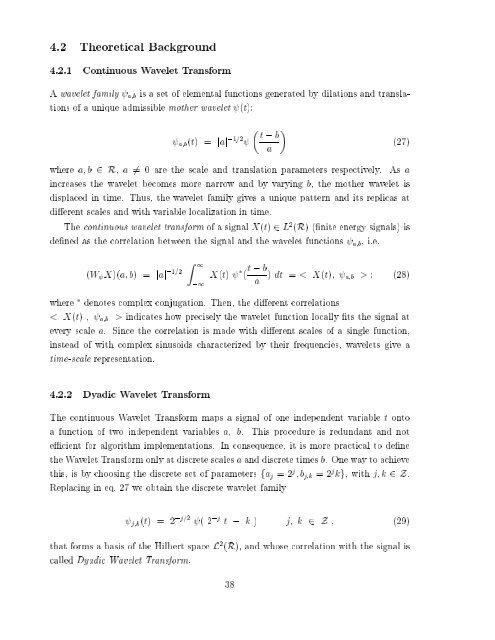Quantitative analysis of EEG signals: Time-frequency methods and ...
Quantitative analysis of EEG signals: Time-frequency methods and ...
Quantitative analysis of EEG signals: Time-frequency methods and ...
Create successful ePaper yourself
Turn your PDF publications into a flip-book with our unique Google optimized e-Paper software.
4.2 Theoretical Background<br />
4.2.1 Continuous Wavelet Transform<br />
A wavelet family ab is a set <strong>of</strong> elemental functions generated by dilations <strong>and</strong> translations<br />
<strong>of</strong> a unique admissible mother wavelet (t):<br />
ab(t) = jaj ;1=2<br />
t ; b<br />
where a b 2 R, a 6= 0 are the scale <strong>and</strong> translation parameters respectively.<br />
a<br />
<br />
(27)<br />
As a<br />
increases the wavelet becomes more narrow <strong>and</strong> by varying b, the mother wavelet is<br />
displaced in time. Thus, the wavelet family gives a unique pattern <strong>and</strong> its replicas at<br />
dierent scales <strong>and</strong> with variable localization in time.<br />
The continuous wavelet transform <strong>of</strong> a signal X(t) 2 L 2 (R) (nite energy <strong>signals</strong>) is<br />
dened as the correlation between the signal <strong>and</strong> the wavelet functions ab , i.e.<br />
(W X)(a b) = jaj ;1=2 Z 1<br />
;1<br />
X(t) ( t ; b<br />
a ) dt = < X(t) ab > (28)<br />
where denotes complex conjugation. Then, the dierent correlations<br />
< X(t) ab > indicates how precisely the wavelet function locally ts the signal at<br />
every scale a. Since the correlation is made with dierent scales <strong>of</strong> a single function,<br />
instead <strong>of</strong> with complex sinusoids characterized by their frequencies, wavelets give a<br />
time-scale representation.<br />
4.2.2 Dyadic Wavelet Transform<br />
The continuous Wavelet Transform maps a signal <strong>of</strong> one independent variable t onto<br />
a function <strong>of</strong> two independent variables a b. This procedure is redundant <strong>and</strong> not<br />
ecient for algorithm implementations. In consequence, it is more practical to dene<br />
the Wavelet Transform only at discrete scales a <strong>and</strong> discrete times b. One way toachieve<br />
this, is by choosing the discrete set <strong>of</strong> parameters fa j = 2 j b jk = 2 j kg, with j k 2 Z.<br />
Replacing in eq. 27 we obtain the discrete wavelet family<br />
jk(t) = 2 ;j=2 ( 2 ;j t ; k ) j k 2 Z (29)<br />
that forms a basis <strong>of</strong> the Hilbert space L 2 (R), <strong>and</strong> whose correlation with the signal is<br />
called Dyadic Wavelet Transform.<br />
38




